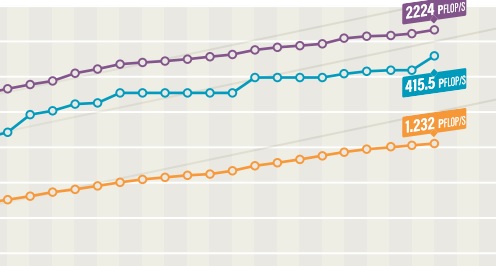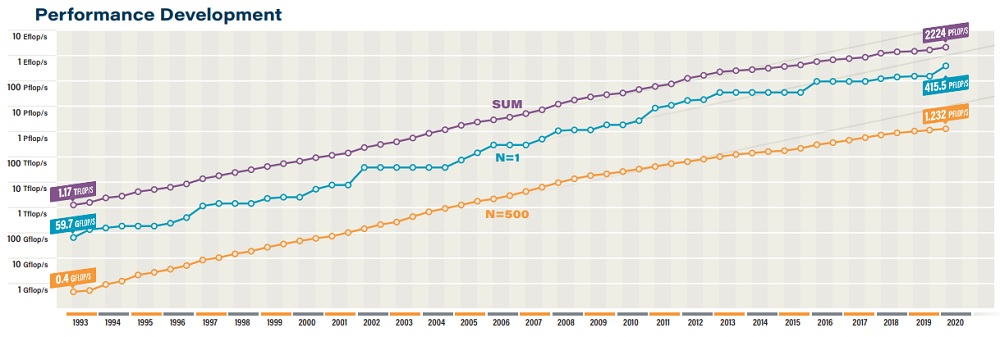The 55th installment of the Top500 list saw strong activity in the leadership segment with four new systems in the top ten and a crowning achievement from the first number-one Arm-based machine, Fugaku (Riken/Fujitsu), however overall the list suffered a record low refresh rate.
Only 51 systems fell off the list this cycle (dipping below the list’s entry point of 1.23 petaflops). That’s the lowest replacement rate the project has seen since its start in 1993, according to Top500 co-author Erich Strohmaier.
Delivering the livestreamed Top500 session on Monday as part of the ISC 2020 proceedings, Strohmaier cited two reasons for the drop off in the refresh rate. “One, we have seen for the last five years reduced turnover in general, as people upgrade less frequently and then upgrade to larger systems, an effect of Dennard scaling breaking down and of progress and chip performance being much slower than it used to be.”
The second is the impact of the COVID-19 crisis with installations that have been delayed, or even canceled. “It’s hard for us to tell which one is what, presumably or hopefully it’s only a delay, and we might catch up in the future again, but we have to see about that. So we have a record low replacement rate,” he said.
That however, said Strohmaier, has not changed another observed trend of the last two decades, which is the increase in accumulation of performance at the top of the list with spending increasingly skewed towards the high-end.

This chart, presented by Strohmaier, shows the performance of the number-one machines relative to the average of all 500, since the list’s inception twenty-seven years ago. The new number-one machine, Fugaku — benchmarked at 415.5 petaflops — leads the pack, contributing a record 18.7 percent of aggregate performance.
The accomplishment propels Japan into third place by installed performance (23.7 percent), just behind China (25.5 percent). The U.S. maintains its lead with 28.7 percent. Fujitsu, while occupying just 2.6 percent of the list by system share, leads on sheer flops with a 21.5 percent share, ahead of Lenovo (16 percent) and IBM (16 percent).

Segmenting the list by the top 100 research systems, the Arm architecture, which only entered the list a year-and-a-half ago, now dominates with a 31 percent performance share, in front of Power/Nvidia (21 percent) and Intel (17 percent).
Likewise Japan also reigns in the top 100 research machine slice with 33 percent, edging out the US (32 percent) and China (12 percent).
The 55th Top500 list may have a record low replacement rate, but with four new systems in the top ten, the turnover at the high-end is up again after a period of very low churn. Six months ago, there were no new machines in the top ten, and the only new entrants in the top 20 were slide-ups due to attrition (Japan’s K computer was decommissioned as was ORNL’s Titan).
Entering the top ten on the new list are:

Fugaku. The new number one machine with 415.5 petaflops, Fugaku is powered by Fujitsu’s 48-core A64FX SoC. It is only the fourth Arm machine ever on the list and the first to grace the number one spot. In fact Fugaku — installed at RIKEN-CCS in Japan — swept top honors not only in High Performance Linpack (HPL), it also set records in HPCG, Graph500 and the new HPL-AI benchmark. Fugaku can also be found in the upper echelon of the Green500, coming in ninth with 14.67 gigaflops-per-watt.
HPC5. Manufactured by Dell and deployed by Italian energy firm Eni S.p.A , HPC5 delivered a Linpack rating of 35.5 petaflops. That makes it the fastest system in Europe and the fastest industry supercomputer. Energy-sector supers keep climbing in the supercomputing ranks, and HPC5 is the first such system to break into the top ten fold.
Selene. Sliding in at number seven with 27.58 HPL petaflops is another industry supercomputer, albeit of the tech industry. Made by and for Nvidia, Selene is an in-house asset for hardware design, model building and other projects. Based in the U.S., Selene is a DGX SuperPOD, powered by Ampere A100 GPUs and AMD’s Epyc Rome CPUs. The system commandeered a second-place ranking on the Green500, delivering 20.51 gigaflops-per-watt of performance.
Marconi-100. Turning in a Linpack score of 21.6 petaflops qualifies Marconi-100 for a ninth-place spot. Installed at the CINECA research center, Marconi was built by IBM with a combination of IBM Power9 processors and Nvidia V100 GPUs. Marconi-100 is purported to be largest academic supercomputer in Italy and in Europe.
And… the fifth new highest-ranked entrant to the list — Gadi — comes in at number 25 with 9.3 Linpack petaflops. Built by Fujitsu in partnership with Lenovo and installed at NCI Australia, Gadi is powered by Intel Xeon Cascade Lake processors and Nvidia V100 GPUs. Gadi is the most powerful supercomputer in the Southern Hemisphere.
This is the first list to cross an exaflops of HPL performance solely owing to the top 100 systems. The previous list (November, 2019) nearly crossed this threshold but fell just shy at 989 petaflops. Currently, the top 100 machines contribute 1.5 exaflops to the list with .4 of those, of course, coming from Fugaku. The top ten systems alone amass 942.6 petaflops.
The aggregate Linpack performance provided by all 500 systems is 2.22 exaflops, up from 1.65 exaflops six months ago. The Linpack efficiency of the entire list is up more than 3 points: 63.6 percent compared with 60.0 percent six months ago. In the same period, the Linpack efficiency of the top 100 segment ticked up from 68.1 percent to 71.3 percent. The number one system, Fugaku, delivers a healthy computing efficiency of 80.87 percent.



























































